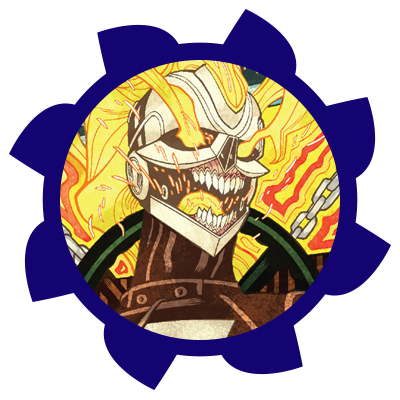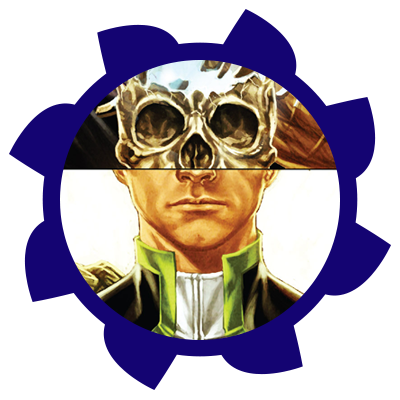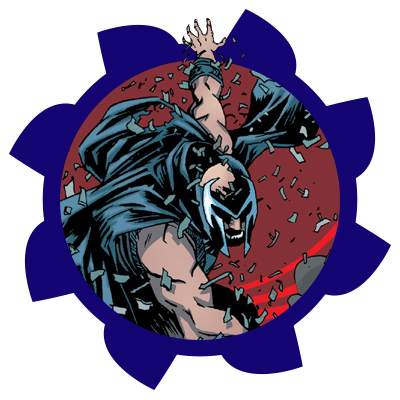Welcome to
the first instalment of Weekly Cogwheels! Here we are going to put together
our thoughts about new comic books, and form one post with mini-reviews.
Well, originally,
we were planning to release it on Monday, but due to my uncanny ability to
screw any deadline… here we are. Now, we will be talking about different comics
that were released on the 20th of August. My friend Victor Ark joined me today to discuss Magneto and Life After, while I shared my thoughts on Original Sins, All-New Ghost
Rider and also criticised last issue of The
Wicked + The Divine a little bit. I will also write about Multiversity #1 some other time. There
were other books that are worth mentioning, such as Ms. Marvel, Secret Avengers, Dark Horse Presents, Trees, etc. We
just did not have place to discuss them this time.

 The Wicked + The Divine #3
The Wicked + The Divine #3
Writer: Kieron GillenArtist: Jamie McKelvie
Colours: Matthew Wilson
“The Wicked + The Divine” is my favourite ongoing series
right now. It is bright, colourful, sexy and intriguing. Each issue is worth
waiting every month.
Now, this
particular issue I did not like. It
was hard to admit this to myself, really - I am a diehard fan of Gillen/McKelvie/Wilson creative team.
But “The Wicked + The Divine #3” felt kind of blank, comparing to other issues.
It revolves just around two themes - the underground fight and Lucifer’s take
on each god, while Laura and Cassandra search for the person that framed goddess
of deceive (I still believe Luci is responsible).
Laura
visits underground scene, where she witnesses not-so-typical lovers’ fight. In
the red corner is Baphomet - “Andrew
Eldritch”-type god with a scandalous attitude. In the blue corner is
goddess of war with multiple personality disorder Morrigan/Badb/Gently Annie.
Both arrogant and both deadly, their quarrel would most definitely result in
causalities. And that’s just it.
This battle
was a way to introduce two gods, their powers and relationship between each
other. But besides the basic superhuman brawl, there is little to discuss
anything else. It was “okay” and “The
Wicked + The Divine” does not deserve to be simply “okay”, you know?
McKelvie’s
character designs are always stunning, and this time is no different. The triple
goddess has three distinctive looks that give away the main features of her
personalities. Morrigan is a majestic front stage-persona, while Badb is her
own “Mr. Hyde”, fierce and hot-tempered, and there is also Gentle Annie, aka Anann - a dispassionate walking plague,
that does not care about anything. And she has that Kate Bishop smile. The
crow-stylish costumes all share resemblance, though they are so different at
the same time.
What
concerns me about Jamie’s work here is the use of black space. There are two
pages that provide minimum artwork (if any), and instead are covered in plain
black. Previous issue also saw three-page sequence with a lousy usage of comics
space, and preview on Comics Alliance even suggested that those pages were
not completed. I do realize that it is a special way to deliver the story, but
it seems a bit odd and… cheap? We all know, Jamie is capable of producing more
complex layouts, and I would like to see more of those.
Second part
of the issue is dedicated to ruling out different suspects in Luci’s set up. It
was nice to hear some new details on gods’ personalities, even if it comes out
of Lucifer. Beyond that: not so much to talk about.
I am still
in love with this series. However, it would be nice to see more colourful and
engaging scenes in the future. I guess, I can hope for that.
 All-New Ghost Rider #6
All-New Ghost Rider #6
Writer: Felipe Smith
Artist: Damion Scott
Colours: Val Staples и Felipe Sobreiro
The reason I
have been reading “All-New Ghost Rider”
was Tradd
Moore, and since he left the title, I’ve certainly been pushed away
from it. I wonder, how long “All-New
Ghost Rider” will last, it does not have big sales, from what I have heard…
The new artist is Damion Scott, whose graffiti-inspired style seems like a good fit
for Robbie Reyes’s adventures. Not
too many action-scenes in the issue this time, so we cannot talk about Scott’s take
on series dynamics. Damion likes to put the images in a twisted perspective point
of view. Not Ron Wimberly-like, but enough to insert dynamics in simple
things.
And Felipe
Smith decided to stick to the theme of his first arc, which is somewhat
refreshing, since most of his colleagues usually move away from it. I am fond
of street-level stories, and Smith depicts bullying, drug dealing and gang wars
quite solidly. These are topical problems, that will sadly be topical for some
time, and it is always nice to have a book, that acknowledges these issues,
even in cartoonish way.
 Original Sins #5
Original Sins #5
Writers: Al Ewing, Ryan North, Chip Zdarsky
Artist: Butch Guise, Ramon Villalobos, Chip Zdarsky
Colours: Matthew Wilson, Jordan Gibson, Chip Zdarsky
This series
is a tie-in to a global event named “Original
Sin”, which revolves around discoveries of untold stories of Marvel
characters. Major retcon-series, you know. And “Original Sins” covers the stories of characters which are left
behind in the main series or tie-ins. As a matter of fact, each issue consists
of one character-centred story, one part of “Young
Avengers” story by Ryan North and Ramon Villalobos, and
two-page amusing comics about some ludicrous stuff. So, the 5th
issue does not disobey the overall structure, and we get the Nick Fury-centred story by Al
Ewing and Butch Guise, brilliant confessions of superheroes by Chip
Zdarsky and conclusion for “Young
Avengers” story from regular team.
Al Ewing and Butch Guise brought to
light one of many sins of Nick Fury. This one is related to his Howling
Commandos pal, Dum Dum Dugan, who was
a prominent character in Nick Fury
and Captain America comics. I should
not go into the specifics of the plot, because of a huge spoiler alert, but
this story does provide a heavy retcon-twist.
Any other “Original Sin”-story being told did not contain such a shameless
destruction of a character. Not that I am upset by it, I am rather shocked, in
a good way. Wish that every single “Original Sin” tie-in would actually made me
to give a heck about them. This one did. Also, nice Steranko mimicking, Mr.
Guice!
“Young Avengers” by Kieron Gillen, Jamie McKelvie and Mike
Norton was my favourite comic book of 2013. When I heard that they are
bringing the crew back with other authors, I was rather sceptical about the
whole idea. I fancy Villalobos’s art, but I never read anything from Ryan
North before. So I tried it, and to be honest, this story was not worth
telling. Hulkling, Marvel Boy and Prodigy go on the hunt for Hood, who is
trying to take advantage of the situation and try to steal other peoples’
secrets. Each issue goes back and forward with the same situation: Young
Avengers capture Hood and make a deal, he betrays them, they capture him on the
next panel, make a deal again, etc. To tell the least, it was boring to
witnesses such unexplainably repetitive story with mostly flat jokes and dull premise.
It has nothing in common with previous “Young Avengers” run, the tone of the
book is just different. I need to acknowledge, that some of the jokes were fun and
Villalobos’s art was good as ever.
Two-page
comics by Chip Zdarsky is all over the net already, and I should say,
that it was the best thing about this mini-series in general. Oh, Chip, you are
inimitable.

 Magneto #8
Magneto #8
Writer: Cullen Bunn
Artist: Javier Fernandez
Colours: Dan Brown
Nobody
expected solo adventures of powerless Magneto
to be good, but it appeared to be a sleeper hit, along with “Superior Foes of Spider-Man”. However, while “Foes” is a funny sitcom about
lame supervillains with extra amount of gags, “Magneto” is a dark tale of one of the most recognizable villains
with no place to joke around. It does not need jokes, anyway.
Separated
from Scott Summers and his Uncanny X-Men, Magneto seeks for a
vendetta against mutant offenders. His punishments are quite ingenious, since Eric
is now limited in his abilities to control magnetism. Magneto is weak, but he
has nothing to lose. In #8 Eric finds himself in an abandoned town. He compares
this town to the living organism, and discusses its “death” from the point of
god’s will. Later one of contrabandists
compares depowered Magneto with this dead town, and Eric admits he is wrong.
Magneto was a god, that could frighten people with a glance, and now it’s only looks that can instil the fear. Cullen
Bunn hints at it using flashbacks and Eric’s inner thoughts. He
prepares reader for a cliffhanger: Magneto will not bear with his power loss.
He was hunting down Marauders for the
same reason.
Cullen Bunn’s
script is good, but it uncovers its strengths
with talented artists. Both Gabriel Hernandez Walta and Javier
Fernandez perfectly fit for the depressive tone of the comic book, as
well as Dan Brown’s coloring.
“Magneto” still
had not disappointed the reader, but it will be put under serious testing: next
month sees the start of “Axis”. And if
does not decrease the quality of the series, I have no idea what will.
 The Life After #2
The Life After #2
Writer: Joshua Hale Fialkov
Artist: GABO
Colours: GABO
Joshua Hale Fialkov, who is known for his awesome Ultimates and Ultimate FF
runs, decided to tell the story of afterlife. There is no Heaven or Hell -
instead of those there is a complicated system with separation into categories
by the cause of death (suicide, murder, etc.). Everyone has their own world,
where he has to follow established rules and schedule. Though they have no idea
about any of it.
This is
what happened to the comic book’s protagonist Jude, until he picked the handkerchief,
lost by a redheaded girl. And that’s where the weirdness starts: the bus driver
did not want Jude to get off the bus, the world started to crumble, and when
Jude touched someone, he caught a glimpse of their horrible past. But Jude was
not the first person to disobey the system. It was Ernest Hemingway, who had greeted
the main heroes at the end of #1.
The ongoing
series is only started to spin, but it is clear, that Fialkov has created a
well-thought universe with many nuances.





No comments:
Post a Comment